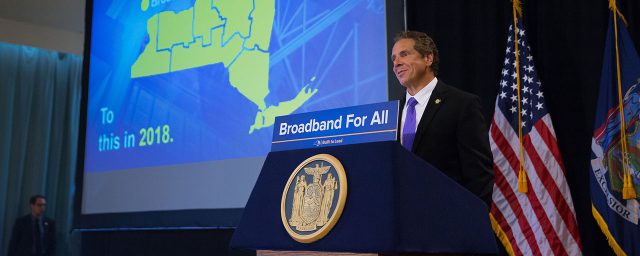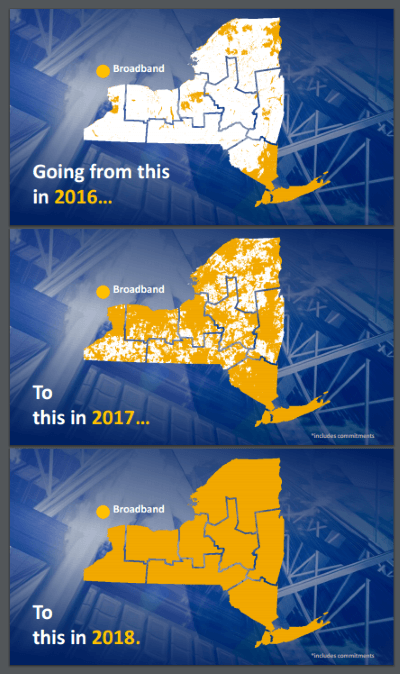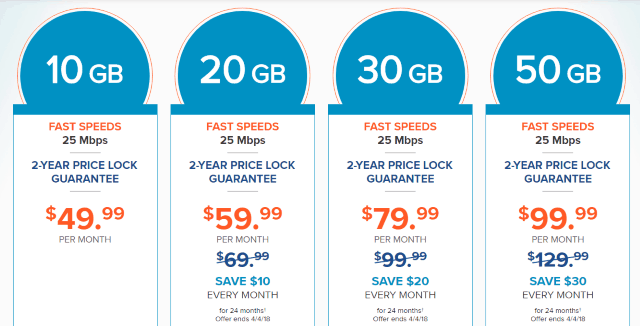
Gov. Andrew Cuomo announcing rural broadband initiatives in New York.
It was called “Broadband for All” — New York Governor Andrew Cuomo’s commitment to bring high-speed internet service to every New York State resident. But it now appears the governor will break that promise and leave more than 72,000 rural New York residents with satellite-delivered internet that does not come close to meeting the broadband speed standard and is infamous for customer frustration, slow speeds, and low data caps.
Ensuring High-Speed Internet Access for Every New Yorker
In today’s world, internet connectivity is no longer a luxury—it is a necessity. Broadband is as vital a resource as running water and electricity to New York’s communities and is absolutely critical to the future of our economy, education, and safety.
In 2015, Governor Cuomo made the largest and most ambitious state broadband investment in the nation, $500 million, to achieve statewide broadband access by 2018.
The New NY Broadband Program sets as its goal access to speeds of 100 Mbps for all New Yorkers, with 25 Mbps acceptable in the most remote and rural areas. The cost must not exceed $60 and there is a general prohibition of data caps. This goal exceeds requirements of the FCC’s Connect America Fund program and requires that projects be completed on a more accelerated timeline.
Today, the governor announced the state grant winners to split $209.7 million in the third and final round of awards to offer 122,285 additional homes, businesses, and institutions broadband internet service.

“These latest awards through Round III of the New NY Broadband Program will close the final gap and bring high-speed broadband to all New Yorkers in every corner of the state,” the governor’s office claimed.
Except it won’t.
Tucked in among the grant award winners is a $14,889,249 grant to Hughes Network Systems, LLC, targeting 72,163 rural New Yorkers, more than half of the total number of customers to be reached in the third round. Hughes operates the HughesNet satellite internet service, a technology derisively known as “satellite fraudband” for routinely failing to meet its advertised speed claims. It’s also known as “last resort internet” because it is slow, expensive, and heavily data capped.
Complaints about HughesNet are common on websites like Consumer Affairs:
“Extreme false advertising. Over the first 30 days with HughesNet Gen5, I averaged 3 Mbps download when advertised 25 Mbps. I canceled when they couldn’t answer why I used 20 GB of data in less than 24 hours. I am a 55 year old average internet user. No streaming. No music. No videos (YouTube). DO NOT GET THIS SERVICE EVEN IF NO OTHERS ARE AVAILABLE.” — Dennis, Tazewell, Tenn. (1/25/2018)
“HughesNet claims high speed internet in our region. Clearly not available here, 3 service calls, with exchange of equipment, 50 calls – recorded leaves us no choice, we demand that this contract be null/void without stealing $399 cancellation. A despicable Company, uninformed customer service, average speeds with a video; upload speed 0.62 Mbps, the download speed is 1.28 Mbps. Help!!!” — Jeffrey, Kerhonkson, NY (1/21/2018)
“Promised speeds of no less than 25 Mbps. Actual speed received was 5-9 Mbps. Unable to stream anything. Computer programs did not operate and did not update as required. We have cancelled HughesNet at great cost to us. Worst internet service ever.” — Jennifer, Hartsville, SC (1/12/2018)

Pat (last name withheld) lives 1.3 miles from the nearest Charter Communications customer in Niagara County, near Niagara Falls and is very disappointed with recent developments. Charter has quoted an installation fee of $50,000 to extend their cable service and Verizon has refused to provide DSL service, leaving Pat resorting to using an AT&T mobile data plan, which is expensive and gets throttled after using more than ~22 GB a month.
“This was a scam from Jump Street,” Pat said. “Phase 3 has 70,000 out of 120,000 homes getting satellite internet, a technology that was already available. It also gives $70 million to Verizon who declined funds in first place. Five years and $675 million later and still no internet for my kids.”
 “This is a huge disappointment for us,” Pat added. “We were counting on this happening. Told numerous times it would. Now we have to debate moving, we can’t continue not having internet. My oldest son just graduated high school never having internet at home.”
“This is a huge disappointment for us,” Pat added. “We were counting on this happening. Told numerous times it would. Now we have to debate moving, we can’t continue not having internet. My oldest son just graduated high school never having internet at home.”
“I have written and spoke with New York Broadband Program Office and it was clear to me from the beginning they didn’t understand the problems they faced, namely infrastructure costs,” said Pat. “They didn’t want to hear it. They wrongly assumed that telecoms would bid and everyone would have internet. I knew when announcements were delayed that the bids for last mile didn’t come in. Tragic really. I think they made a mistake accepting that money from the FCC. Satellite was never on the table until that happened.”
Stop the Cap! readers have told us satellite internet is the worst possible option for internet access, and many have reported better results relying on their mobile phone’s data plan. But New York’s solution for more than 70,000 of its rural citizens — many that believed the governor’s commitment of 100% coverage — is to saddle them with satellite internet access starting at $49.99 a month for a paltry 10 GB of usage per month. The top plan on offer costs $99.99 a month and is capped at 50 GB a month before a speed throttle kicks in and reduces speeds to dial-up levels. A 24-month contract is required with a very steep early cancellation penalty.
Another surprising winner is Verizon Communications, a company that originally refused to participate in rural broadband expansion efforts. Verizon will accept more than $70 million to expand its broadband service to 15,515 homes, businesses, and institutions in the Capital Region, central New York, the North Country, and Southern Tier. At press time, it is not known if Verizon will bring FiOS or DSL to these customers.
Because New York State relied on private companies to bid to cover unserved residents, it seems clear HughesNet is the default choice for those New Yorkers stranded without a telecom company bidder. Although that will allow Gov. Cuomo to claim his program reaches 99.99% of New Yorkers, the rural broadband problem remains unresolved for those who were depending the most on New York to help bring broadband to rural farms, homes in the smallest communities, and those simply unlucky enough to live in small neighborhoods deemed unprofitable to serve.


 Subscribe
Subscribe
So what is the punishment for HughesNet if/when they can not supplied the speeds and data caps that have been outlined by the contract? After reading your first article I thought awesome a state that is finally getting tough on the providers. if anyone can make a rock solid contract New York can. Unfortunately I have to agree I see the walk back already starting. They should of had a contingency plan before promising things based on there fate of providers.
I think Pat’s quote has a lot of merit. The Broadband Program Office was optimistic that with matching funds available, there would be no reason not to serve everyone, or close to it. Don’t get me wrong — I doubt the third round would have actually had enough funds to reach EVERY New York resident that wanted service. I think the state underestimated provider intransigence to invest in low/non Return On Investment areas. In Pat’s case, Charter wanted $50,000 to extend cable service to a home that is 1.3 miles from the nearest Spectrum customer. I don’t know if that… Read more »
I find many of the things on here disturbing.., ” It also gives $70 million to Verizon who declined funds in first place.” “At press time, it is not known if Verizon will bring FiOS or DSL to these customers.”.. DSL, for the most part, does not fit the description as “broadband”, anymore.. Broadband is now 24 Mb down.. Most DSL, from what I know, is WAY under that.. “that will allow Gov. Cuomo to claim his program reaches 99.99% of New Yorkers”.. Sad, but first he does not get his facts right, then he makes promises that he can… Read more »
We now know Verizon will use fiber as a substantial part of its expansion. However, they can meet the FCC’s speed definition using VDSL and not have to run fiber direct to homes. It seems likely fiber to home service would be necessary to achieve 100 Mbps, but the speed standard for rural areas in this program is lower. We also know very little about HughesNet and this program. HughesNet is already available so presumably this money will somehow subsidize the service for rural New Yorkers. How it does that I do not know. It could be free equipment, it… Read more »
I’m afraid I might be one of the 72,000. I have DSL now and have had Hughes prior to that. I can tell you DSL is much better than Hughes. It’s very slow, but at least there’s no cap and the speeds have been consistent for the past year since fewer people have to use it now. I’m in Malone (North Country) and it’s mostly Spectrum around here. I’m hopeful even though my census block is not a part of Round 3 that Mohawk Network’s fixed wireless will still reach my area. They are expanding around here very quickly and… Read more »
I unfortunately am also one of the few (many) who will still be left with satellite as my only option. We’ve had Hughesnet for about a year and a half when we moved here to the hilltowns of rural Albany County. It’s equivalent to a half-step above dial-up and that’s being generous. The caps are ridiculous. Once you’ve “used up” your data, (and we only use internet for email, social media, etc… no streaming), the speed is reduced so badly it’s horrible. I can log onto my email, go do a load of laundry and mow the lawn… and the… Read more »
I didn’t even get Hughesnet. No discounts, or anything. Despite my only internet provider being VZ DSL which is around 1Mbps max due to distance from CO. This program failed miserably around where I am in Otsego county. Look at any map of the area and you’ll see just how overwhelmingly unserved we are. It’s like they skipped us entirely.